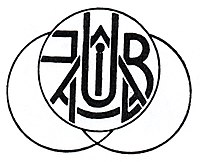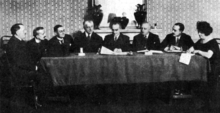Union Internationale des Fédérations des Amateurs de Billard
| Union Internationale des Fédérations des Amateurs de Billard (UIFAB) |
|
|---|---|
 Logo (1931)
|
|
| sport | Collision |
| Founded | 1924 (1903) |
| Place of foundation | Paris |
| president | Charles Faroux |
| Chairman | Albert Corty |
| Board | Jean Albert |
| Association headquarters | Paris |
The Union Internationale des Fédération des Amateurs de Billard (UIFAB) was a French World Association for amateur players in the collision . It emerged from the predecessors Fédération des Sociétés Françaises des Amateurs de Billard (FSFAB), Fédération Française de Billard (FFB), Fédération Française des Amateurs de Billard (FFAB) and the Fédération Internationale des Amateurs de Billard (FIAB).
history
1903 to 1923
The two French Frantz Reichel , actually François-Étienne Obus Reichel, was only called "Frantz" in the French media as they came from Alsace, and Théodore Vienne initiated the first amateur world championship in cadre 35/2 in 1903 . Since there was still no association in Europe, they founded the "Fédération des Sociétés Françaises des Amateurs de Billard" (FSFAB) on the evening after the World Cup ended on March 22, 1903. Raymond de Drée became president (only called “Comte de Drée” in the French media), Reichel became general secretary, Vienne and some committed players at the World Cup were also founding members and on the board.
After just three days, disagreements about the rules and the definition of the amateur status of players caused a scandal, whereupon Reichel and Vienne left the FSFAB and two months later founded the Fédération Française de Billard (FFB). For a decade, both associations existed in parallel, both hosted world championships and both excluded players from the other association from participating in "their" World Cup. Such quarrels can be seen in billiards to this day. This happened in the 1980s and 1990s between the UMB and the BWA , and in 2019 between the former and the Korean Professional Billiards Association (PBA), which was founded in March of that year .
In order to be allowed to participate in the respective world championships, foreign players, the FSFAB also cooperated with the US American association "National Association of Amateur Billiard Players" (NAABP, world's oldest amateur association; founded 1899), had to become members of the respective association. From Germany these included Albert Poensgen and Hellmuth Kux, who joined the FSFAB. The FSFAB hosted the 1903 World Championships in cadre 35/2 on match billiards (still common at the time), and cadre 45/2 was not played until 1906. The FFB relied on Cadre 45/2 from the start.
After talks, on December 19, 1913, the two associations were merged and re-established as the “Fédération Française des Amateurs de Billard” (FFAB). According to the agreements made at that time, only the FFB world championships were dubbed the "official world championships", although the FSFAB united the stronger players and from 1909 onwards most of the nations were represented. In contrast to the FFB, it also entered into collaborations with other associations and always tried to establish a world association. The reason given for this was the registration of the name “Championat du Monde” (World Championship) in French courts, and the FFB thus owned the naming rights. Only de Drée was still actively represented by the FSFAB on the board of the new association, Vienne was "only inactive honorary president", Reichel was no longer represented. The FFAB strived for internationalization, towards a world association, but the First World War destroyed these plans.
1923 to 1959

Only a decade later, on 16./17. December 1923 was founded in Brussels "Café Marnix" with the "Fédération Internationale des Amateurs de Billard" (FIAB) a world association. For the first time, an umbrella organization for the organization of world and European championships was created. Hardly a year later it was called on 30./31. October 1924 in "Union Internationale des Fédération des Amateurs de Billard" (UIFAB). It was renamed again on June 1, 1959 to become today's Union Mondiale de Billard (UMB). The reason for this was again quarrels, this time caused by the then President Charles Faroux and other board members. The tensions mainly affected the national associations of Germany, Belgium and the Netherlands. August 1956 the Fédération Internationale de Billard (FIB), to organize its own European championships, founded. Thereupon the dissolution of the UIFAB could not be stopped and on July 12, 1958 the European continental association Confédération Européenne de Billard (CEB) was founded and a year later the current world association UMB.
Timeline
Others
The FSFAB played the first two tournaments in cadre 35/2 at match pool and then switched to cadre 45/2 in 1906. The strongest player was the Frenchman Lucien Lérolle, who not only won the first World Cup in 1903 (FFB), but also the World Cup from 1904 to 1907 and in 1909 of the FSFAB. The record in the general average (GD) was held by Alfred Mortier from France with 23.72. The FFB World Championships could only come up with significantly lower averages, as the better players were based in the other association. At the FFB-WM 1913, shortly before the unification of the two organizations, players of the FSFAB were allowed to participate.
A special feature shaped the world championships between 1903 and 1925. Following the US model, the tournament runner-up or third was allowed to challenge the winner to a challenge match. This had to take place within six months of the end of the tournament. The challenge tournaments were divided into three sections over several days. In 1908 the FSFAB played on 1,200 points, in the FFB 1910 and 1912 as well, between 1923 and 1925 the game was then partly played on 1,500 points.
Until the Second World War, with the exception of the First World War, a world championship was played every year. When the first World Cup after the war was played again in 1947, this continuity was lost and only a total of 11 tournaments were held until what was probably the last World Cup in 2003. The game distances were also drastically reduced (400 points) in order to be able to play the tournaments on a weekend (Fri-Sun). At the last tournament in 2003 the game distance was only 300 points. The record winner is the Belgian Théo Moons with 5 gold medals, only Lucien Lérolle had one more medal, if you add the “unofficial” World Championships of the FSFAB.
It was not until 1927, when the Cadre World Championships had already been held for 25 years, that the UIFAB decided to host the first free-game world championship , a discipline that professionals had turned away from as early as 1880 because they had the highest series (HS) of 1,500 points had become boring for the audience and too exhausting for the players. The enlargement of the corner swab in 1948, a measure that has actually been common among professionals since 1879, did not add any tension to the game and so the last World Cup was played in 1969.
The first hosting of the World Championship was a long time coming. It did not take place in Vichy until 1934, and the professionals had already organized their first World Cup in New York in 1881. After four tournaments, the UIFAB initially had no further plans for world championships, and it was only more than 30 years later that the UMB hosted the next World Cup in 1968.
A three-cushion world championship was first considered as early as 1913, but it is not known whether it took place. At that time only the "Championnat Parisienne aux Trois Bandes" was known. In 1928 the plans were so advanced that the first World Cup was held in Reims . It took place annually until the war, after which it had to slowly establish itself again. From 1959 the UMB was able to hold it again annually.
See also
- FSFAB World Championships in Cadre 35/2 and 45/2
- Cadre 47/1 World Championship
- Cadre 47/2 World Championship
- Cadre 71/2 World Championship
- Free game world championship
- Three-cushion world championship
- Binding World Championship
Web links
- Union Internationale des fédérations d'amateurs de billard ... Fantaisie classique. Extraits des règlements internationaux publiés à l'issue de l'Assemblée générale de Luxembourg, 1950 Bibliothèque nationale de France (French)
- Union Internationale des Fédérations d'amateurs de billard. Annuaire Bibliothèque nationale de France (French)
Individual evidence
- ^ A b c Dieter Haase, Heinrich Weingartner : Encyclopedia of Billardsport . 1st edition. tape 1 . Verlag Heinrich Weingartner, Vienna 2009, ISBN 978-3-200-01489-3 , p. XIX – XX .
- ↑ a b c d Dieter Haase, Heinrich Weingartner : Encyclopedia of billiards . 1st edition. tape 1 . Verlag Heinrich Weingartner, Vienna 2009, ISBN 978-3-200-01489-3 , p. 149-151 .
- ↑ Markus Schönhoff: Korea creates a new conflict in billiards. Kozoom , February 22, 2019, archived from the original on February 25, 2019 ; accessed on September 5, 2019 .
- ^ A b Dieter Haase, Heinrich Weingartner : Encyclopedia of Billiards . 1st edition. tape 1 . Verlag Heinrich Weingartner, Vienna 2009, ISBN 978-3-200-01489-3 , p. 163 .
- ^ Dieter Haase, Heinrich Weingartner : Encyclopedia of Billiards . 1st edition. tape 1 . Verlag Heinrich Weingartner, Vienna 2009, ISBN 978-3-200-01489-3 , p. 3 .
- ^ Dieter Haase, Heinrich Weingartner : Encyclopedia of Billiards . 1st edition. tape 2 . Verlag Heinrich Weingartner, Vienna 2009, ISBN 978-3-200-01489-3 , p. 635 .
- ^ Dieter Haase, Heinrich Weingartner : Encyclopedia of Billiards . 1st edition. tape 2 . Verlag Heinrich Weingartner, Vienna 2009, ISBN 978-3-200-01489-3 , p. 785 .



